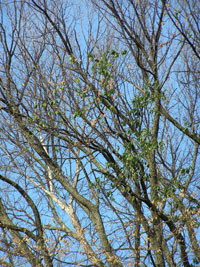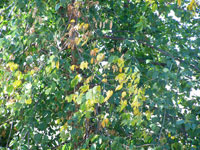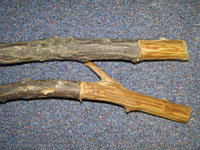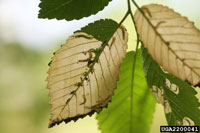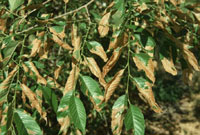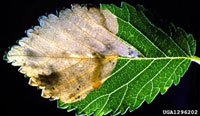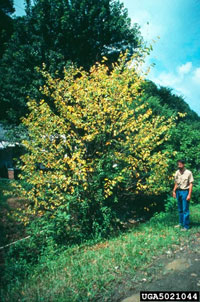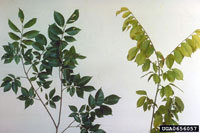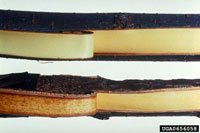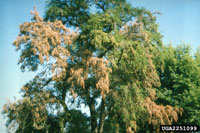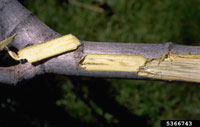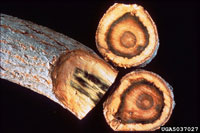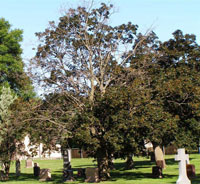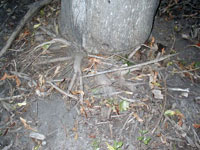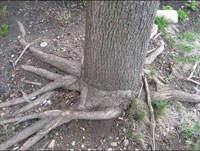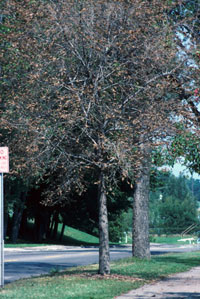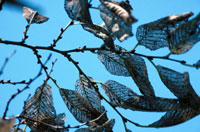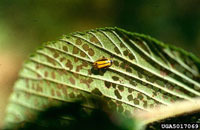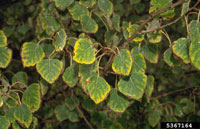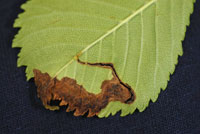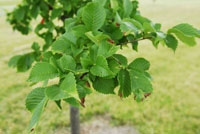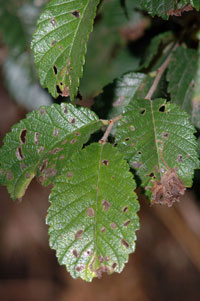Extension > Garden > Diagnose a problem > What's wrong with my plant? > Deciduous Trees > Elm > Leaves partially or completely brown
Elm > Leaves > Leaves partially or completely brown
1 of 8
Dutch elm disease
Ophiostoma ulmi and Ophiostoma novo-ulmi
- Leaves turn yellow, wilt or shrivel, turn brown, then fall off the branch
- Initial infection occurs on one branch; disease may quickly progress to all branches
- Peel back bark on symptomatic branch to reveal brown streaking on wood
- Healthy elms neighboring infected elms soon show symptoms due to spread through root grafts
- Woodpecker holes with bark loss is common on trees killed by Dutch Elm Disease
- American, red or slippery and rock elm are highly susceptible
- More information on Dutch elm disease
2 of 8
Elm leafminer
Kaliofenusa ulmi
- Feed inside leaves, first appearing as serpentine mines and gradually coalescing to give the appearance of brown blotch-like mines between leaf veins
- Damaged leaves may remain on the tree throughout the growing season
- Larvae are translucent white, legless, and are present inside leaves in late spring
- Siberian and red elm are most commonly affected
- More information on Elm leafminer
3 of 8
Elm yellows or Elm phloem necrosis
Elm yellows group or clover proliferation group
- Occasionally, leaves can shrivel, turn brown and remain attached to branches for several weeks
- Leaves in the entire canopy turn yellow, droop and fall off, often all in a few weeks time
- When bark is peeled back, the inner bark is yellow brown and smells of wintergreen (American elm) or maple syrup (red elm)
- Witches’ broom or dense leaf clusters at branch ends, common on red elms
- Damage appears mid to late summer; infected trees die within a year or two
- All Minnesota elm species are susceptible
- More information on Elm yellows
4 of 8
Verticillium wilt
Verticillium dahliae
- Leaves turn brown from the edges and tips, wilt and die in severe infections
- Leaves are small and yellowed in chronic infections
- Leaf symptoms are often seen on only one branch in the canopy
- Dark brown to black streaks often can be seen in the sapwood if the bark is peeled back, appearing as rings or arcs in a cross cut
- Symptoms may develop over a single growing season, or over several years
- More information on Verticillium wilt
5 of 8
Stem girdling roots
- Affected trees commonly exhibit excessive and abnormal winter damage including frost cracks and dieback
- Affected trees are often stunted, exhibit poor summer color, change color and lose their leaves early in the fall
- A root circling the trunk of the tree may be seen at the soil line
- Trunk may become sunken in or compressed where it contacts the root
- If girdling root is below ground, the trunk will lack the natural widening or flare at the soil line so will go straight into the earth like a telephone pole; trees often exhibit an abnormal lean
- Affected trees commonly exhibit water-stress symptoms such as marginal leaf scorch, wilting, sudden leaf fall
- More information on Stem girdling roots
6 of 8
Elm leaf beetle
Pyrrhalta luteola
- Entire leaf canopy can be affected so may look brown from a distance
- During late spring larvae windowpane feed, i.e. eat one layer of leaf tissue between the veins leaving the upper leaf surface intact
- Adults eat small, nearly circular holes in the leaves during spring
- Adults are ¼ to 3/8 inch long and yellow with black stripes along length of wing covers
- Larvae up to 1/2 inch long; dull yellow with lateral black stripes
- Siberian elms are most preferred host followed by American elms
- More information on Elm leaf beetle
7 of 8
Deicing salt injury
- Soil salt damage causes leaf edges or margins to appear burnt or scorched progressing toward the mid-vein
- Salt spray causes branches to become tuft-like (a.k.a. witches’ broom)
- Run-off salt kills roots which results in die-back of most branches
- Affected trees leaf out later than other non-infected trees
- More severe on branches that face the road
- Damage most noticeable in spring
- More information on deicing salts
8 of 8
Elm flea weevil
Orchestes alni
- Larvae create blotch mines at tips of leaves
- Adults eat on leaf undersides creating small holes in leaves
- Adults are brown with black heads, black spots on wings, long snout, 1/8 inch long
- Preferred hosts are Siberian and hybrid elms
- More information on elm flea weevil



